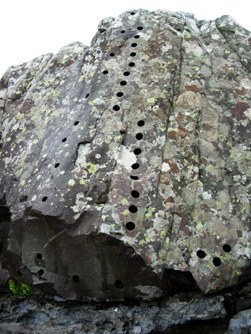
Colin MacFadyen*, Scottish Natural Heritage, is bored by irresponsible sampling
Geoscientist 20.7 July 2010
In 1989 the Geologists’ Association published their Code of Conduct for Rock Coring. It was required to raise awareness of the need to core responsibly, owing to the increasing number of samples taken for geological research purposes, the legacy of which defaced exposures across the UK. Twenty years on, the problem appears to be as bad as ever.
Coring, which is aimed at securing samples for palaeomagnetic and/or geochemical studies, is a necessary element of geological research and therefore essential for the advancement of geoscience. However, an increasing number of classic and other locations across the UK have been defaced by thoughtless researchers, operating without adherence to any code of good conduct, whose behaviour is nothing short of vandalism.
On a recent trip to Ardnamurchan Site of Special Scientific Interest (SSSI), I was horrified to discover that Palaeogene cone-sheets at Mingary Pier had been extensively cored (pictured). Of international conservation value, the natural exposures in this Scottish geological crown jewel have effectively been vandalised to the extent that they would not look out of place in a working quarry. Within the geoscience community this damage has been described as a “desecration … the equivalent of raiding an eagle's nest”, and “utterly unacceptable”.
The outrage at this recent incident stems from the fact that no effort at all was expended to sample in less visually intrusive parts of outcrop or to fill in the holes after the sample had been extracted. It would appear that some researchers behave as if rock exposures are their own private resource to be used in a manner that disregards future use by anyone else - researchers, teachers or geotourists. Irresponsible coring is not restricted to Scotland, depressingly it is ubiquitous across the UK and is internationally recognised as having become a serious conservation issue.
Irresponsible and reckless coring defaces our natural heritage in a manner that is visible to all and sundry. When an outcrop is cored without adherence to good practice guidelines, it is effectively destroyed in terms of imaging, and its teaching and geotourism potential are often considerably diminished. Irresponsible coring gives geological research a bad name, irritates landowners and therefore threatens future research. Legislation exists in the UK to protect designated sites from the reckless activities of third parties. If good practice guidelines continue to be ignored prosecutions are a possibility.
In the UK some researchers claim that they would behave differently toward exposures within SSSIs, suggesting that irresponsible coring outside a designated site is, in their eyes, acceptable. The fact is that whenever and wherever any exposure is sampled, sampling should be undertaken responsibly, respecting its value to conservation. If it’s worth coring it’s worth conserving.
A change in attitude is required to end this geo-vandalism. It is sad that there is a need to resurrect the Geologists’ Association Code of Conduct for Rock Coring, as geoscientists nowadays should know better.
* Dr Colin MacFadyen is Policy and Advice Officer (Geologist), Scottish Natural Heritage. E: [email protected]. The Coring Code of the GA forms part of the fieldwork code and can be downloaded at www.geologists.org.uk/downloads/GAfieldworkcode.pdf